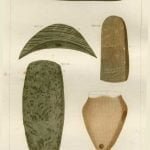
There is no instance, it is believed, among the North American Indians, in which the war-club employed by them is made of a straight piece, or has not a recurved head. Generally, this implement consists of a shaft of heavy wood, such as the rock maple, with a ball carved at one side of the head, much in the manner of the South Sea Islander, or Polynesian war-clubs.
Such is the Pug-ga-ma-gun of the Algonquins. It differs from the Polynesian club, chiefly in its possessing a tabular shaft, and in its less elaborate style of carving. Clubs exhibited at the war dance or other ceremonial exhibitions, are always larger than those intended for practical use, and partake decidedly of a symbolical character.
A practice has prevailed since the introduction of iron, of combining a lance with the same implement. It is then shaped somewhat in the form of the butt end of a gun or rifle, but having more angular lines. A lance of iron, of formidable dimensions, is inserted at the intersection of the most prominent angle. This fearful weapon, which appears to be the most prominent symbol of war, is very common among the prairie tribes. No warrior is properly equipped without one. It is often elaborately ornamented with war eagles feathers, and with paints and devices. Brass tacks are sometimes used in the lance-clubs as ornaments, and not infrequently a small hand looking glass is sunk or inserted in the tabular part of the handle. It was then intended to be stuck in the ground, and to serve the warrior to make his war toilet. Figures of these several species will be inserted under the head of “Manners and Customs.” Of the antique mace, such as was in use prior to the discovery of the country, descriptions, accompanied by plates, have been given under the head of “Stone-bill,” or Pointed Mace; see Plate 11, Fig. 1.
